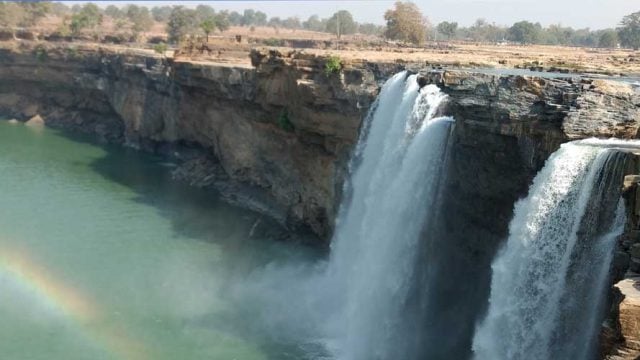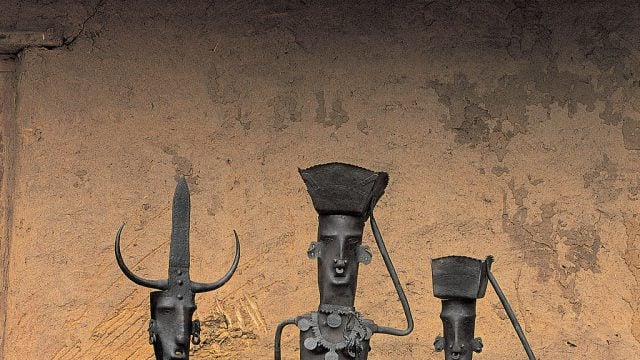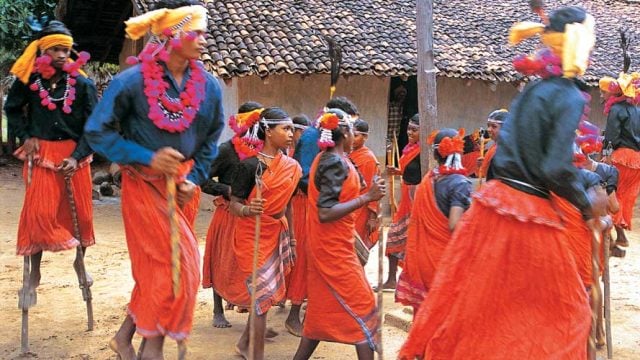BHEDAGHAT, MADHYA PRADESH sizes="(max-width: 660px) 100vw, 660px" />
sizes="(max-width: 660px) 100vw, 660px" />
The misty marble-rock waterfalls of the Narmada at Bhedaghat, near Jabalpur, can be crossed by ropeway or admired from the Panchwati nouka vihaar or boathouse. Called the Dhuandhar, this majestic fall is a favourite with visitors to Jabalpur and its wild braids also draw in pilgrims from the Chausath (64) Yogini temple nearby. The falls are supposed to be a sight to behold from a boat on a moonlit night, and the powdery white sculptures from the local white soapstone make a popular souvenir.
MORENA TEMPLES, MADHYA PRADESH
The small cluster of sandstone temples near Gwalior at Mitawali, Bateshwar and Padawali remains still obscure and this is surprising, given their sheer gorgeosity. Mostly Shiva and a few Vishnu shrines from the Gurjara-Pratihara dynasty, circa 8–10th century, the pre-Khajuraho beauties of Bateshwar were well scarred by their lonely time in the Chambal gorge, and the story of their recent restoration is particularly poignant because they found protectors from among the infamous dacoit gangs of the region. Explicit erotic sculptures as well as the exploits of Krishna decorate the main Vishnu temple of Garhi Padawali. The Mitawali Shiva Temple, by contrast, is a more spare, geometric design, a 64-celled mandala encircling the circular plinth holding the sanctum sanctorum, the shivling housed within. The womb of the universe? Who knows! Meanwhile, excavation is on at Dodamath, where another little cluster has been found even as the 10-hectare Bateshwar complex of 200 shrines is being arduously restored.

DHUBELA, MADHYA PRADESH
Just 50km from Khajuraho, on the road towards Orchha and Jhansi, sits an old fort by a lake. The old seat of Maharaja Chhatrasal, the 16th-century capital of Orchha is aptly dotted with chhatris and palaces. But this fort houses the Dhubela Museum, the state’s largest, with relics of the Bundela dynasty’s rule, from the weapons and garments of the time to paintings and sculptures suggestive of a Shakti cult. Covering the Gupta, Kalchuri and Chandela periods, the oldest artefacts date back to the 3rd century and down to Adil Sher Shah’s elegant light cannon from the 18th.

MAIHAR, MADHYA PRADESH
The seat of the mother goddess Sharada Devi stands on Trikuta Hill, near Satna and not far from Jabalpur, supposedly the spot where either her necklace or collarbone fell during the divine Sati episode. The temple is reached up 1063 steps, and locals maintain that one of their local heroes—Alha and his brother Udal gave Prithviraj Chauhan himself a hard time, and Alha was blessed with eternal life by the devi herself for their devotion—still drops by to salute her at dawn, centuries after his birth. But the capital of the Rajput lords of Maihar princely state can actually trace its history back to the Paleolithic Era. It is also home to the Maihar music gharana instituted by Ustad Allauddin Khan. And it has inspired in turn an unusual residency programme, called Art Ichol, for artists and writers. It is also a ceramics studio, and the retreat itself is architecturally intriguing with its Khaparel tiles and mortar made of brick powder and lime, and the elegantly updated traditional rooms.

VIDISHA, MADHYA PRADESH
If you are swinging by Sanchi, don’t forget to visit the legendary medieval city of Vidisha with its many layers of history. Near its eastern limits, you will find the unfinished Bijamandal, seemingly an unfinished temple from the 11th-century Paramara period. Curiously, sitting atop its plinth is a small 14th-century mosque, which uses a pillar inscribed with a devotional to the goddess Chamunda that seems to date back to the rule of King Naravarman in the early 12th century! Nearby sits a 7th-century stepwell bearing what appear to be the earliest extant sculptures honouring Krishna. Not far afield is the Satdhara monastic cluster and the Udaygiri caves, with sanctuaries and sculptures dating back to the 4th and 5th centuries in the rule of Chandragupta II. Then there is Khamba Baba, a Garuda pillar saluting Vishnu that was raised by Heliodorus of Taxila, a monument older than the 2nd century BC that is the earliest testimony of the use of lime mortar, i.e. a precursor of cement, in India. And then there is Gyaraspur, sitting in a gorge and home to the Maladevi Temple showing evidence of originally being a Jain Adinath shrine from the 8th–10th century as well as the Bajramath Temple of three shrines now held by Jain Digambars though it seems to have originally housed the Hindu Surya, Shiva and Vishnu. Don’t miss the Hindola Torana, a delicate gateway that should remind you of the Gwalior shalabhanjika that was excavated here because of the sculptures up it sides.

THE BUDDHIST HERITAGE OF SIRPUR, CHHATTISGARH
Hiuen Tsang spoke in eulogies of Sirpur, once the seat of the kings of Koshala, and a place of Hindu and Buddhist and Jain heritage. From the 6th to the 10th century AD, it was perhaps even more honoured by the Buddha’s followers than the fabled university of Nalanda. And then, in the 12th century, the city on the banks of the Mahanadi was buried by an earthquake. Excavations uncovered not only twelve Buddhist viharas and a Jain one, but also monolithic sculptures of the Buddha and Mahavira, a 6th-century Ayurvedic spa complete with snaan kund, and an underground granary and grain exchange! Several Shiva and Vishnu temples too emerged, though the most famous is the 7th-century Laxman Temple, richly carved and exquisitely symmetrical. Especially intriguing is the Gandheshwar Temple, though, peopled with a Buddha and a Ravan as well as a Durga, Garuda and Nataraj, plus rare depictions of Shiv-leela. The most impressive of the Buddhist monasteries is the Anandprabhu Kutir Vihara, with the six-foot seated Buddha in bhumisparsha mudra. Panchatantra carvings adorn the walls of the Teevardeo-sanctioned monastery excavated only in 2003. Don’t miss the mysterious white ziggurat-ish Surang Tila either.
Madhya Pradesh
unexplored destinations
Leave a Reply
You must be logged in to post a comment.





